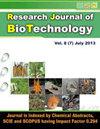Facile Preparation and Characterization of Alginate and Triton X-100 Zinc Phosphate modified Surface Nanocrystals as a Novel Anti-corrosive and Antibacterial agent
IF 0.2
Q4 BIOTECHNOLOGY & APPLIED MICROBIOLOGY
引用次数: 0
Abstract
In this study, two surface-modified antibacterial and anti-corrosive nanoparticles (ZnP-T, ZnP-ALG) were synthesized by facile and efficient one-step ultrasonic synthesis method. Nanocrystals were characterized by X-ray Diffraction (XRD), Fourier Transform Infrared (FT-IR), Energy Dispersive X-Ray Analysis (EDX), Scanning Electron Microscopy (SEM) and Transmission electron microscopy (TEM). The TEM image showed that the product had good dispersion with a particle size of 10-23, 15–32 nm respectively. Antibacterial and cytocompatibility properties were studied by agar diffusion, in vitro viability and cytotoxicity assay (MTT) and colony-forming-unit (CFU). Antibacterial rate of the ZnP-T and ZnP-ALG nanoparticles reached near 100% and cell viability was near 100%. The corrosion resistance of ZnP-T and ZnP-ALG was evaluated by the electrochemical impedance spectroscopy (EIS) approach. Nyquist diagrams demonstrated that the ZnP-ALG sample had better protection than the ZnP-T sample at all immersion time . The frequency phase angle of the ZnP-ALG sample (θ10 kHz) has a greater value compared with the ZnP-T case.藻酸盐和 Triton X-100 磷酸锌修饰表面纳米晶体作为新型抗腐蚀和抗菌剂的简便制备与表征
本研究采用简便高效的一步超声合成法合成了两种表面修饰的抗菌防腐纳米粒子(ZnP-T、ZnP-ALG)。通过 X 射线衍射(XRD)、傅立叶变换红外(FT-IR)、能量色散 X 射线分析(EDX)、扫描电子显微镜(SEM)和透射电子显微镜(TEM)对纳米晶体进行了表征。TEM 图像显示,产品具有良好的分散性,粒径分别为 10-23 纳米和 15-32 纳米。抗菌和细胞相容性通过琼脂扩散、体外活力和细胞毒性测定(MTT)以及菌落形成单位(CFU)进行了研究。ZnP-T 和 ZnP-ALG 纳米粒子的抗菌率接近 100%,细胞存活率接近 100%。ZnP-T 和 ZnP-ALG 的抗腐蚀性是通过电化学阻抗光谱(EIS)方法进行评估的。奈奎斯特图显示,在所有浸泡时间内,ZnP-ALG 样品都比 ZnP-T 样品具有更好的保护性能。与 ZnP-T 样品相比,ZnP-ALG 样品的频率相位角(θ10 kHz)值更大。
本文章由计算机程序翻译,如有差异,请以英文原文为准。
求助全文
约1分钟内获得全文
求助全文
来源期刊

Research Journal of Biotechnology
BIOTECHNOLOGY & APPLIED MICROBIOLOGY-
CiteScore
0.60
自引率
0.00%
发文量
192
期刊介绍:
We invite you to contribute Research Papers / Short Communications / Review Papers:
-In any field of Biotechnology, Biochemistry, Microbiology and Industrial Microbiology, Soil Technology, Agriculture Biotechnology.
-in any field related to Food Biotechnology, Nutrition Biotechnology, Genetic Engineering and Commercial Biotechnology.
-in any field of Biotechnology related to Drugs and Pharmaceutical products for human beings, animals and plants.
-in any field related to Environmental Biotechnolgy, Waste Treatment of Liquids, Soilds and Gases; Sustainability.
-in inter-realted field of Chemical Sciences, Biological Sciences, Environmental Sciences and Life Sciences.
-in any field related to Biotechnological Engineering, Industrial Biotechnology and Instrumentation.
-in any field related to Nano-technology.
-in any field related to Plant Biotechnology.
 求助内容:
求助内容: 应助结果提醒方式:
应助结果提醒方式:


